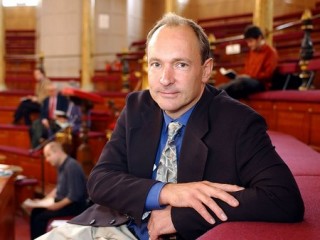
Tim Berners-Lee biography
Date of birth : 1955-06-08
Date of death : -
Birthplace : London, England
Nationality : British
Category : Science and Technology
Last modified : 2010-05-20
Credited as : Engineer and computer scientist, MIT professor , invented the World Wide Web (www)
44 votes so far
Tim Berners-Lee was born in London, England, on 8 June 1955, the son of Conway Berners-Lee and Mary Lee Woods. He attended Sheen Mount primary school, and then went on to Emanuel School in London, from 1969 to 1973. He studied at The Queen's College, Oxford, from 1973 to 1976, where he received a first-class degree in Physics.
Berners-Lee is the director of the World Wide Web Consortium (W3C), which oversees the Web's continued development. He is also the founder of the World Wide Web Foundation, and is a senior researcher and holder of the 3Com Founders Chair at the MIT Computer Science and Artificial Intelligence Laboratory (CSAIL). He is a director of The Web Science Research Initiative (WSRI), and a member of the advisory board of the MIT Center for Collective Intelligence. In April 2009, he was elected as a member of the United States National Academy of Sciences, based in Washington, D.C.
Career
While an independent contractor at CERN from June to December 1980, Berners-Lee proposed a project based on the concept of hypertext, to facilitate sharing and updating information among researchers. While there, he built a prototype system named ENQUIRE. After leaving CERN in 1980, he went to work at John Poole's Image Computer Systems, Ltd, in Bournemouth, England, but returned to CERN in 1984 as a fellow. In 1989, CERN was the largest Internet node in Europe, and Berners-Lee saw an opportunity to join hypertext with the Internet: "I just had to take the hypertext idea and connect it to the Transmission Control Protocol and domain name system ideas and — ta-da! — the World Wide Web." He wrote his initial proposal in March 1989, and in 1990, with the help of Robert Cailliau, produced a revision which was accepted by his manager, Mike Sendall. He used similar ideas to those underlying the Enquire system to create the World Wide Web, for which he designed and built the first Web browser, which also functioned as an editor (WorldWideWeb, running on the NeXTSTEP operating system), and the first Web server, CERN HTTPd (short for HyperText Transfer Protocol daemon).
The first Web site built was at CERN, and was first put on line on 6 August 1991.
n 1994, Berners-Lee founded the World Wide Web Consortium (W3C) at MIT. It comprised various companies that were willing to create standards and recommendations to improve the quality of the Web. Berners-Lee made his idea available freely, with no patent and no royalties due. The World Wide Web Consortium decided that its standards should be based on royalty-free technology, so that they could easily be adopted by anyone.
In 2001, Berners-Lee became a patron of the East Dorset Heritage Trust, having previously lived in Colehill in Wimborne, East Dorset, England.
In December 2004, he accepted a chair in Computer Science at the School of Electronics and Computer Science, University of Southampton, England, to work on his new project, the Semantic Web.
Current work
In June 2009 Prime Minister Gordon Brown announced Berners-Lee would work with the UK Government to help make data more open and accessible on the Web, building on the work of the Power of Information Task Force. Berners-Lee and Professor Nigel Shadbolt are the two key figures behind data.gov.uk, a UK Government project to open up almost all data acquired for official purposes for free re-use. Commenting on the opening up of Ordnance Survey data in April 2010 Berners-Lee said that: "The changes signal a wider cultural change in Government based on an assumption that information should be in the public domain unless there is a good reason not to - not the other way around." He went on to say "Greater openness, accountability and transparency in Government will give people greater choice and make it easier for individuals to get more directly involved in issues that matter to them."
In November 2009, Berners-Lee launched the World Wide Web Foundation in order to "Advance the Web to empower humanity by launching transformative programs that build local capacity to leverage the Web as a medium for positive change."
Berners-Lee is one of the pioneer voices in favour of Net Neutrality, and has expressed the view that ISPs should supply "connectivity with no strings attached," and should neither control nor monitor customers' browsing activities without their express consent.
In a Times article in October 2009, Berners-Lee admitted that the forward slashes ("//") in a web address were actually "unnecessary". He told the newspaper that he could easily have designed URLs not to have the forward slashes.
















